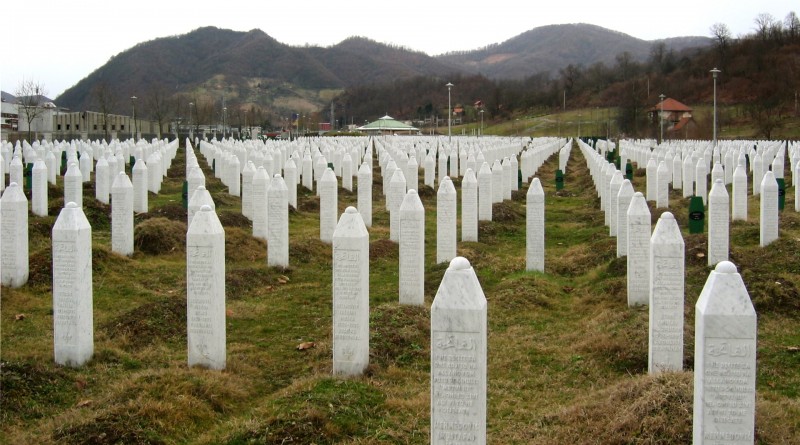Survivor of Srebrenica recounts escaping genocide
By: Nadia Dreid – SHFWire
WASHINGTON – Semir Osmanovic never got a chance to say goodbye to his grandfather.
When the Serbian soldiers began separating the men from the women near Srebrenica, a city in Eastern Bosnia, Osmanovic, huddled with sister and grandparents under a tree. The children were warned to keep quiet in the hopes they would evade the soldiers’ notice.
“The word genocide is defined as the deliberate killing of a large group of people, especially those of a particular ethnic group or nation,” Osmanovic said. “The Serbs did exactly that in July of 1995.”
Osmanovic spoke on Capitol Hill Friday about his experience escaping genocide at an event commemorating the 20th anniversary of the massacre at Srebrenica.
During the Bosnian War in 1995, which began after Bosnia-Herzegovina declared its independence from communist Yugoslavia, Serbian forces unleashed an ethnic cleansing campaign on Bosnian Muslims near Srebrenica. The Srebrenica massacre left over 8,000 Bosnian Muslim men and boys dead within the space of a few days – including every adult male in Osmanovic’s family.
Throughout the night, the air was filled with the sounds of weeping, screaming and gunshots. Osmanovic’s grandfather held him tight and told him everything would be all right.
“Even though I was small,” Osmanovic said, “I could sense that he was in disbelief of that even as he was saying it.”
Somehow, they lasted three days before they were told they would be loaded onto a bus and moved to another city. But his grandfather was stopped by a Serbian soldier.
“My grandma started crying. She started pleading. …She kept saying, ‘No, don’t take him. He didn’t do anything wrong,’” Osmanovic said. “At that point, the soldier said, ‘He can go alone or all of you can join him. It’s up to you.’”
The Serbian soldier took his grandfather’s bag and threw it in a pile with dozens of others before leading him away. It was the last time Osmanovic saw him.
“My grandfather turned around and told my grandma, ‘I want you to keep walking. Don’t look back, and please take care of the kids.’”
War criminals
Eight years later, Osmanovic was living with his grandmother and sister in Virginia, plagued by sleepless nights and nightmares of what they had survived. But they weren’t alone.
Thousands of other Bosnians had come to the U.S., fleeing the horrors of war. Among them were hundreds of former Serbian soldiers, some of whom took part in the genocide at Srebrenica.
Michael MacQueen, senior historian of the Human Rights Violators and War Crimes Unit of U.S. Immigration and Customs Enforcement, is charged with helping track down those criminals. He said they often come into the country under false pretenses or with forged documents.
“We rightly regard Srebrenica to be much more than the killings, keeping in mind the accompanying crimes of torture, rape and unlawful violent expulsion,” MacQueen said.
About 300 suspects have been identified. ICE officials have begun the process to deport about half of them.
“It took thousands of men to carry it out. Not just the commanders and shooters, but the planners, the supply chiefs, the coordinators, the guards, the drivers, the infantrymen and the grave diggers,” MacQueen said. “Just because someone did not pull the trigger does not mean they did not assist in the achievement of genocide.”
Laid to rest
Shortly after coming to the U.S., Osmanovic searched the Internet for information about the massacre. He found video shot by a Serbian reporter that showed a group of Bosnian civilians surrendering to Serbian troops, surrounded by the fallen bodies of the executed. One face stood out.
“I could not believe my eyes, but it was my father,” Osmanovic said. “I lost all hope that I would ever see my father again.”
The victims were buried in mass graves. Slowly, those graves have been found and the bodies identified, due to the efforts of the International Commission of Missing Persons. In 2010, on the 15th anniversary of the massacre, Osmanovic was able to bury his father, uncle and grandfather.
Today, Osmanovic lives in Richmond, Va., and studies finance at Virginia Commonwealth University. He still wonders about the people responsible for the deaths of so many.
“Sometimes, I think to myself what it must have taken to kill over 8,000 people in such a short amount of time,” Osmanovic said. “Do those who committed the genocide ever think about it? Does it haunt them at night?”
Reach reporter Nadia Dreid at nadia.dreid@scripps.com or 202-408-1491. For coverage reported from a UD student, click here.
Photo: Nearly 7,000 of Srebrenica’s more than 8,000 victims have been identified and nearly as many have been buried. The Srebrenica Genocide Memorial in Srebrenica, Bosnia and Herzegovina, is now the final resting place of thousands of the massacre’s victims. WikiCommons photo by Michael Büker.

